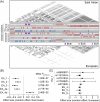Transethnic analysis identifies SORL1 variants and haplotypes protective against Alzheimer's disease
- PMID: 39655505
- PMCID: PMC11772736
- DOI: 10.1002/alz.14214
Transethnic analysis identifies SORL1 variants and haplotypes protective against Alzheimer's disease
Abstract
Introduction: The SORL1 locus exhibits protective effects against Alzheimer's disease (AD) across ancestries, yet systematic studies in diverse populations are sparse.
Methods: Logistic regression identified AD-associated SORL1 haplotypes in East Asian (N = 5249) and European (N = 8588) populations. Association analysis between SORL1 haplotypes and AD-associated traits or plasma biomarkers was conducted. The effects of non-synonymous mutations were assessed in cell-based systems.
Results: Protective SORL1 variants/haplotypes were identified in the East Asian and European populations. Haplotype Hap_A showed a strong protective effect against AD in East Asians, linked to less severe AD phenotypes, higher SORL1 transcript levels, and plasma proteomic changes. A missense variant within Hap_A, rs2282647-C allele, was linked to a lower risk of AD and decreased expression of a truncated SORL1 protein isoform.
Discussion: Our transethnic analysis revealed key SORL1 haplotypes that exert protective effects against AD, suggesting mechanisms of the protective role of SORL1 in AD.
Highlights: We examined the AD-protective mechanisms of SORL1 in the general population across diverse ancestral backgrounds by jointly analyzing data from three East Asian cohorts (ie, mainland China, Hong Kong, and Japan) and a European cohort. Comparative analysis unveiled key ethnic-specific SORL1 genetic variants and haplotypes. Among these, the SORL1 minor haplotype, Hap_A, emerged as the primary AD-protective factor in East Asians. Hap_A exerts significant AD-protective effects in both APOE ε4 carriers and non-carriers. SORL1 haplotype Hap_A is associated with cognitive function, brain volume, and the activity of specific neuronal and immune-related pathways closely connected to AD risk. Protective variants within Hap_A are linked to increased SORL1 expression in human tissues. We identified an isoform-specific missense variant in Hap_A that modifies the function and levels of a truncated SORL1 protein isoform that is poorly investigated.
Keywords: APOE; East Asian; European; PET; Pittsburgh compound B; amyloid load; association; plasma biomarker; protective.
© 2024 The Author(s). Alzheimer's & Dementia published by Wiley Periodicals LLC on behalf of Alzheimer's Association.
Conflict of interest statement
The authors declare no conflicts of interest. Author disclosures are available in the Supporting information.
Figures






References
-
- 2022 Alzheimer's disease facts and figures. Alzheimers Dement. 2022;18:700‐789. - PubMed
-
- Bellenguez C, Grenier‐Boley B, Lambert J‐C. Genetics of Alzheimer's disease: where we are, and where we are going. Curr Opin Neurobiol. 2020;61:40‐48. - PubMed
-
- Bertram L, Tanzi RE. Alzheimer disease risk genes: 29 and counting. Nat Rev Neurol. 2019;15:191‐192. - PubMed
MeSH terms
Substances
Grants and funding
- C6027-19GF/Research Grants Council of Hong Kong
- 21K07271/Grants-in-Aid for Scientific Research from the Ministry of Education, Culture, Sports, Science, and Technology (MEXT) of Japan
- CTFCF18SC01/Chow Tai Fook Charity Foundation
- 2021Szvup137/Fundamental Research Program of Shenzhen Virtual University Park
- ITS/207/18FP/Innovation and Technology Commission
- JP23dk0207060/Japan Agency for Medical Research and Development
- MRP/097/20X/Innovation and Technology Commission
- N_HKUST605/20/National Natural Science Foundation of China (NSFC)/RGC Joint Research Scheme
- 21H03537/Grants-in-Aid for Scientific Research from the Ministry of Education, Culture, Sports, Science, and Technology (MEXT) of Japan
- InnoHK ITCPD/17-9/Innovation and Technology Commission
- U01 AG024904/AG/NIA NIH HHS/United States
- HKUST16103122/General Research Fund
- AoE/M-604/16/Areas of Excellence Scheme of the University Grants Committee
- T13-605/18 W/Theme-Based Research Scheme
- MRP/042/18X/Innovation and Technology Commission
- 2019B1515130004/Guangdong Provincial Fund for Basic and Applied Basic Research
- 32061160472/National Natural Science Foundation of China (NSFC)/RGC Joint Research Scheme
LinkOut - more resources
Full Text Sources
Medical
Miscellaneous

